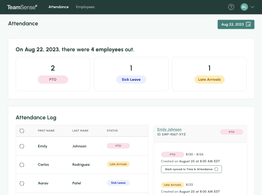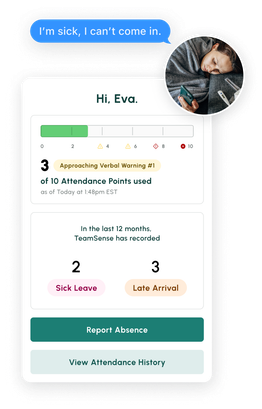Fix the root cause of No-Call No-Show with help from TeamSense
When an employee is absent, you need to know what kind of absence and when the employee will return to the office. When you have that information, you can cover their shift and make sure work continues as planned. But that’s not all. You also need to track used time off against accruals and determine if an employees’ absence requires follow-up action, such as a disability leave or workers compensation claim.
According to the CDC Foundation, productivity losses linked to absenteeism cost roughly $1,685 per employee per year. To maintain productivity, it’s essential to keep detailed time and attendance records and stay on top of employee absences.
4 Questions to Include in your Employee Call Off Process:
What is the reason for the absence?
What type of absence is it?
What is the expected duration of the absence?
Are there other details that are important for the call off process?
What is the reason for the absence?
On the surface, it may seem that the absence type is the same as asking about the reason for an absence, for example, if an employee is calling in sick. However, if the sickness is due to a work accident or injury, or if an employee has COVID-19 symptoms, you need to know.
The Americans with Disabilities Act limits the questions employers can ask employees who are absent due to illness, but it does permit disability-related questions if they are related to an employee’s job.
Here are some possible absence reasons employees could select when replying to this question:
Pre-planned time off
Personal emergency
Work-related illness or accident
COVID-19 symptoms
Other disability
What type of absence is it?
Employee absences can fall into many categories, and each has different implications for how you plan for a replacement. For example, you need to know whether employees are using accrued vacation time or if they’re sick and might be out for an unknown number of days.
To make it easier for employees to reply, it’s a good idea to establish standardized answers employees can select from a dropdown or other list. Possible absence types include the following:
Vacation time
Personal day
Family medical leave
Sick time
Other unplanned absence

Save Hundreds of Hours A Year With TeamSense
See how TeamSense saved HelloFresh 3-4 hours per day managing attendance through text. Read the case study and book your demo today!
What is the expected duration of the absence?
When employees request time off for a vacation, it’s easy to know when they will return to work. Buf for unexpected absences, the return-to-work date is sometimes less clear. By asking employees when they expect to return to work, you can put together a tentative plan for making sure you have ample shift coverage during their absence.
To track employee absences as accurately as possible, it’s advisable to make sure you give employees the ability to record their absence duration down to the hour to accurately track as much information as possible.
Hour durations That way, whether employees will be out the whole day or just a few hours, they can respond to this question. You can allow employees to enter the number of hours or work days they will be absent, or you can provide an option to enter a day and time of the expected return-to-work date. For employees who are unsure of their return, you can allow them to select an “undetermined” or similar response.
Are there any other details that are important for the call off process?
Sometimes there is additional information about an absence that employees want to convey, but it doesn’t fit well into the other absence questions.
For example, employees may have physician-ordered work restrictions after returning to work, such as limits to how much weight they can lift after surgery. In such cases, it makes sense to give employees the option of providing additional information.

Is your call-in process terrible? Text reduces no-shows and absenteeism by up to 40%.
Don't believe us? Check out this case study to see how this 3PL benefited.
About the Author

Sheila Stafford, CEO of TeamSense & AI in HR Innovator
As CEO of TeamSense, Sheila Stafford is at the forefront of transforming HR for frontline teams through AI-driven solutions. With a commitment to enhancing employee relations and simplifying workforce management, Sheila leads TeamSense in pioneering advancements that empower both frontline employees and HR teams. Her visionary approach combines cutting-edge technology with a thoughtful focus on enhancing human connection; Sheila strategically implements AI where it adds the most value while recognizing the critical role of personal interaction and ensuring that human engagement remains central when it matters most. Under her leadership, TeamSense is redefining how companies support and engage their frontline teams for a more connected, efficient workplace.





